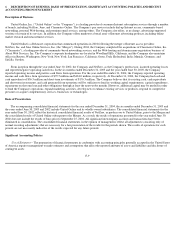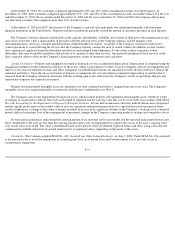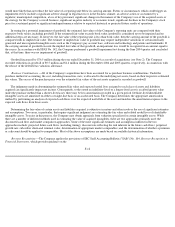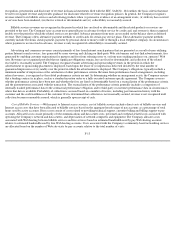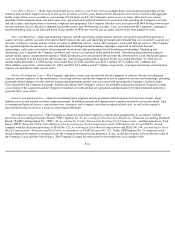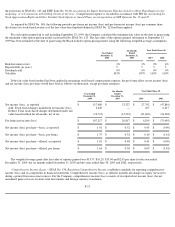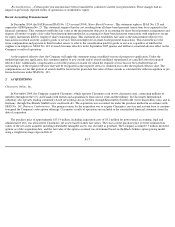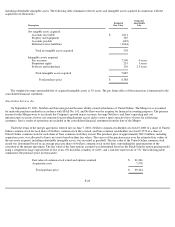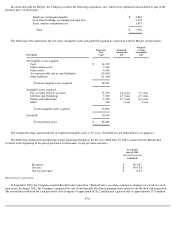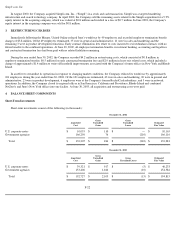Classmates.com 2004 Annual Report Download - page 81
Download and view the complete annual report
Please find page 81 of the 2004 Classmates.com annual report below. You can navigate through the pages in the report by either clicking on the pages listed below, or by using the keyword search tool below to find specific information within the annual report.
would more likely than not reduce the fair value of a reporting unit below its carrying amount. Events or circumstances which could trigger an
impairment review include a significant adverse change in legal factors or in the business climate, an adverse action or assessment by a
regulator, unanticipated competition, a loss of key personnel, significant changes in the manner of the Company's use of the acquired assets or
the strategy for the Company's overall business, significant negative industry or economic trends, significant declines in the Company's stock
price for a sustained period or significant underperformance relative to expected historical or projected future results of operations.
In testing for a potential impairment of goodwill, the estimated fair values of the Company's reporting units are compared with their
respective book values, including goodwill. If the estimated fair value exceeds book value, goodwill is considered not to be impaired and no
additional steps are necessary. If, however, the fair value of the reporting unit is less than book value, then the carrying amount of the goodwill is
compared with its implied fair value. The estimate of implied fair value of goodwill may require independent valuations of certain internally
generated and unrecognized intangible assets such as the Company's pay account base, software and technology and patents and trademarks. If
the carrying amount of goodwill exceeds the implied fair value of that goodwill, an impairment loss would be recognized in an amount equal to
the excess. In accordance with SFAS No. 142, the Company performed a goodwill impairment test during the June 2004 quarter and concluded
that, at that time, there was no impairment of goodwill.
Goodwill increased by $76.5 million during the year ended December 31, 2004 as a result of acquisitions (see Note 2). The Company
recorded reductions in goodwill of $9.5 million and $1.4 million during the December 2004 and 2003 quarters, respectively, in connection with
the release of the deferred tax valuation allowance.
Business Combinations —All of the Company's acquisitions have been accounted for as purchase business combinations. Under the
purchase method of accounting, the cost, including transaction costs, is allocated to the underlying net assets, based on their respective estimated
fair values. The excess of the purchase price over the estimated fair values of the net assets acquired is recorded as goodwill.
The judgments made in determining the estimated fair value and expected useful lives assigned to each class of assets and liabilities
acquired can significantly impact net income. Consequently, to the extent an indefinite-lived or a longer-lived asset is ascribed greater value
under the purchase method than a shorter-lived asset, there may be less amortization recorded in a given period. Definite-lived identifiable
intangible assets are amortized on either a straight-line basis or an accelerated basis. The Company determines the appropriate amortization
method by performing an analysis of expected cash flows over the expected useful life of the asset and matches the amortization expense to the
expected cash flows from those assets.
Determining the fair value of certain assets and liabilities acquired is subjective in nature and often involves the use of significant estimates
and assumptions. Two areas, in particular, that require significant judgment are estimating the fair value and related useful lives of identifiable
intangible assets. To assist in this process, the Company may obtain appraisals from valuation specialists for certain intangible assets. While
there are a number of different methods used in estimating the value of acquired intangibles, there are two approaches primarily used: the
discounted cash flow and market comparison approaches. Some of the more significant estimates and assumptions inherent in the two
approaches include: projected future cash flows (including timing); discount rate reflecting the risk inherent in the future cash flows; perpetual
growth rate; subscriber churn and terminal value; determination of appropriate market comparables; and the determination of whether a premium
or a discount should be applied to comparables. Most of the above assumptions are made based on available historical information.
Revenue Recognition —The Company applies the provisions of SEC Staff Accounting Bulletin ("SAB") No. 104, Revenue Recognition in
Financial Statements,
which provides guidance on the
F-12









